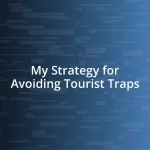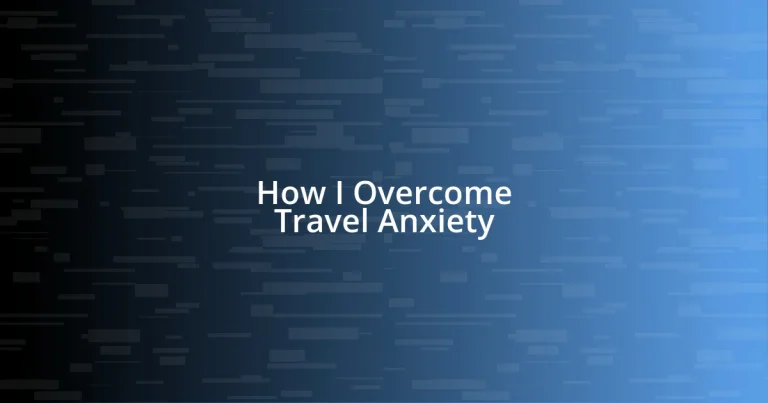Key takeaways:
- Travel anxiety is common, stemming from worries about logistics, unfamiliar environments, and uncertainties, but acknowledging these feelings is vital for overcoming them.
- Identifying personal triggers and employing preparation techniques, such as visualization and grounding exercises, can significantly help manage anxiety before and during travel.
- Seeking professional help and connecting with supportive communities provide valuable insights and coping strategies, creating a sense of camaraderie and shared experiences among travelers.

Understanding Travel Anxiety
Travel anxiety is more common than many realize, and I’ve certainly felt its grip myself. The anticipation of a journey can quickly morph into a whirlwind of worries—what if I miss my flight? Or worse, what if I forget something crucial? I remember standing at the airport, my heart racing as I fumbled through my bag, convinced I’d left my passport at home.
Another layer to this anxiety often stems from the fear of the unknown. Have you ever found yourself feeling overwhelmed by the thought of being in a new city where you don’t speak the language? I once arrived in a bustling foreign market, surrounded by unfamiliar faces and sounds. My stomach dropped as self-doubt washed over me—would I find my way back to my hotel? This experience taught me that acknowledging those feelings of apprehension is the first step to overcoming them.
Understanding travel anxiety isn’t just about identifying the feelings; it’s about recognizing that these emotions are valid and so many others experience them too. I often contemplate how many fellow travelers walk through the same terminal, grappling with their own inner turmoil. It’s this shared experience that can transform anxiety from something isolating into a collective challenge that we can face together.

Identifying Your Triggers
Identifying your triggers is a crucial step in managing travel anxiety. For me, pinpointing specific situations that elevate my stress has been transformative. I realized that certain environments, like busy airports or crowded train stations, tend to make me feel particularly anxious. As I identified these settings, I started to prepare myself mentally for how to cope when faced with them.
To help you in this journey of discovery, consider these common triggers that might resonate with you:
- Fear of missing a connection: The anxiety of not making a flight or train can be overwhelming.
- Social interactions: Trying to communicate in a foreign language can spike my nerves.
- Uncertainty of plans: Change in itinerary or lack of a detailed plan often heightens my anxiety.
- Physical discomfort: Long waits in uncomfortable seats or feeling unwell can amplify feelings of unease.
- Traveling solo: The sense of being alone in a foreign place can trigger feelings of vulnerability.
Each time I confront these triggers, I’m reminded that self-awareness is a powerful tool in the face of anxiety. The more I take note of what specifically rattles my peace of mind, the better equipped I become to navigate those feelings in a healthier way.

Preparing Your Mindset
Preparing your mindset for travel can make all the difference in combating that pesky anxiety. I have discovered that visualization techniques work wonders for me. Before I embark on a journey, I take a few moments to imagine myself navigating through the airport, boarding the plane, and arriving at my destination with ease. Whenever I picture myself relaxed and confident, it shifts my mindset significantly. Have you ever tried visualizing your success before a trip? It’s a practice that allows me to mentally rehearse the positive outcomes I desire.
Another approach I’ve found helpful is grounding exercises. On particularly anxious days, I take a moment to focus on my breathing. Deep, steady breaths help anchor my thoughts and calm my racing heart. Reflecting on past trips that turned out surprisingly well reminds me that I have faced challenges before and come out stronger. One trip that stands out is when I accidentally boarded the wrong train. Instead of panicking, I found a way to laugh at myself and ended up discovering an unexpected gem of a town. This experience reinforced my belief that keeping a positive mindset opens the door to exciting new adventures, even when plans go awry.
Lastly, I think it’s crucial to embrace the emotions associated with travel. Instead of viewing fear solely as a negative force, I try to recognize it as a natural part of the journey. Journaling my feelings about upcoming trips has proven to be incredibly cathartic for me. Expressing my worries on paper often brings clarity and turns anxious thoughts into manageable concerns. And each time I look back on those entries after a trip, I see how my fears rarely materialized, reinforcing my belief in my ability to handle whatever comes my way.
| Mindset Techniques | Personal Reflection |
|---|---|
| Visualization | Picturing success helps shift my mindset. |
| Grounding Exercises | Deep breathing anchors my thoughts and calms my nerves. |
| Embracing Emotions | Journaling turns fear into clarity and reassurance. |

Practical Coping Techniques
When I first realized I needed to take a proactive approach to travel anxiety, packing a “calm kit” became a game-changer for me. This kit isn’t just about snacks or travel-size toiletries – I include items that bring me comfort. For instance, a small lavender sachet helps soothe my nerves, while a playlist of calming music provides a mood lift during tense moments. Have you considered what might bring you a sense of peace while traveling?
Another technique that has made a significant difference is establishing a pre-travel routine. I set aside an hour before any trip to unwind and organize my thoughts. This could mean sipping herbal tea, meditating, or decluttering my luggage to ensure I have everything I need. It’s amazing how this ritual acts as a lovely buffer between my everyday life and the upcoming travel adventure. Do you have a ritual that helps you transition into travel mode?
Finally, I’ve learned the importance of connecting with fellow travelers. Sometimes, sharing experiences with others can light up a path to overcoming that anxious feeling. On one occasion, I struck up a conversation with a stranger while waiting for our flight. We chatted about our dream destinations, and it turned out to be a highlight of my travel day! This interaction not only distracted me from my anxiety; it opened my eyes to the camaraderie within the travel community. What if engaging with others could transform your travel experience too?

Planning Your Travel Itinerary
When I think about planning my travel itinerary, I honestly feel like I’m crafting an adventure roadmap. I often start by making a list of must-see attractions, but what really helps reduce my anxiety is breaking it down into smaller chunks. For instance, instead of cramming too many activities into a single day, I prioritize a few key experiences. This way, I have a sense of purpose without overwhelming myself. Have you ever felt the weight of trying to see it all at once? I know firsthand how that can dampen the excitement of a trip.
I also prioritize flexibility in my plans. One time, while visiting a bustling city, I had a whole day planned but ended up getting lost in a local market that had captured my heart. Instead of stressing about the itinerary, I allowed myself to embrace the spontaneity. That unexpected detour turned out to be one of the most memorable parts of my trip. Isn’t it fascinating how the unplanned moments can often lead to the best stories?
Finally, I believe in the power of visual tools. When I started using travel apps that let me map out my itinerary visually, it transformed how I approached my trips. Seeing my plans laid out clearly helps me manage my time better and calms my anxious thoughts. It’s like having a personal assistant who gently guides me through each day. Have you ever considered how visualizing your itinerary could ease your travel jitters? It’s these little touches that can really make a difference.

Utilizing Relaxation Strategies
One of the relaxation strategies I find incredibly effective is guided imagery. Before my last trip, I took a few quiet moments to close my eyes and visualize myself enjoying the journey. I imagined the sights, sounds, and even the smells of my destination. This immersive experience helped ease my nerves by allowing my mind to feel as though I had already arrived in a safe and serene environment. Have you ever tried visualizing your travels to reduce anxiety?
Another approach that has worked wonders for me is deep breathing exercises. I remember standing in line at the airport, feeling those anxious butterflies stirring up inside me. In that moment, I focused on taking slow, deep breaths: inhaling for a count of four, holding for four, and exhaling for four. It was amazing how this simple technique brought a wave of calm over me, transforming my anxiety into a sense of clarity. Isn’t it fascinating how our breath can anchor us amidst all the chaos of travel?
Lastly, I’ve found great comfort in yoga and stretching. On one trip, I woke up feeling particularly anxious about the long flight ahead. Instead of letting that tension build, I rolled out my mat for a quick session in my hotel room. The gentle stretches and flowing movements helped release physical tension and ground me mentally. It’s in those moments of physical connection that I remind myself how capable I am of handling whatever comes my way. Have you considered incorporating even a few minutes of stretching during your travels? It can truly make a world of difference.

Seeking Professional Help
Seeking professional help is a step I’ve found invaluable when grappling with travel anxiety. I remember a particularly challenging trip where my worries felt insurmountable. After reflecting on my experiences, I decided to consult a therapist specializing in anxiety. The sessions not only provided me with coping strategies, but they also granted me an understanding of the triggers behind my anxiety. Have you ever thought about how professional guidance could illuminate your own experiences?
In therapy, I learned about cognitive-behavioral techniques, which transformed my mindset. For instance, I practiced reframing my anxious thoughts into positive affirmations. Instead of telling myself, “What if something goes wrong?” I began to say, “I am capable of handling whatever comes my way.” It was like flipping a switch; I felt empowered rather than fearful. When was the last time you challenged those negative thoughts?
Seeking professional help also allowed me to connect with support groups focused on travel-related anxiety. Hearing others share their stories made me feel less isolated. I vividly recall one session where a fellow traveler described a similar experience, and we all shared laughs about our travel mishaps. That sense of community was not just comforting; it reinforced the idea that I wasn’t alone in this journey. Have you ever considered how sharing your experiences with others could lighten your emotional load?














